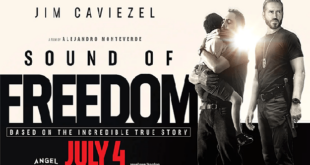PG-13 movies aren’t what they used to be. The Movie Picture Association of America defines PG-13 movies as containing material that may be inappropriate for children under the age of 13. “Parents are urged to be cautious,” the site says, “Some material may be inappropriate for pre-teenagers.”[i]
Pretty self-explanatory, right?
Well, not really. Especially when you take a look at these facts:
- PG-13 movies such as The Hunger Games and The Avengers contain more violence than rated-R movies from the 1980s.[ii]
- Gun violence in PG-13 movies has tripled since 1985 (the year PG-13 ratings first came out).
- The first PG-13 movie releases contained about as much gun violence as G- and PG-rated movies films. But since 2009, PG-13 rated films have contained as much or more violence as R-rated films.[iii
That’s not all. Get this: According to a study by the Annenberg Public Policy Center and University of Pennsylvania “There is essentially no difference between the most popular movies rated PG-13 for younger viewers and restricted, R-rated films in showing main characters engaged in both violence and alcohol use or violence and sexual behavior.”[iv]

Bottom line? PG-13 movies are more violent today than they ever have been. So despite the MPAA’s broad assumption that PG-13 movies are for those 13 years and older, parents must still exercise sound judgment over whether or not the movie is appropriate for young eyes—or theirs, for that matter.
Even G-rated movies are permitted to use “impolite” language. And while a sexually-derived expletive will immediately garner a PG-13 rating, there’s no real “rule” as to how many occurrences of those types of words result in an R-rating. For instance, according to the Classification and Rating Rules effective in 2010,
“The Rating Board nevertheless may rate such a motion picture PG-13 if, based on a special vote by two-thirds majority, the Raters feel that most American parents would believe that a PG-13 rating is appropriate because of the context or manner in which the words are used or because the use of those words in the motion picture is inconspicuous.”[v]
But how to do you justify The Hip Hop Project receiving a PG-13 rating despite containing 17 “F” words—a number that guarantees an R-rating?
Well, because Director Matt Ruskin and Chris “Kazi” Rolle, the film’s subject, appealed the initial R rating—and won. Their rationale? “We decided to appeal the R rating to allow teenagers access to see this film because they’re the ones who need it most.”[vi]
Need it most?!
Have they ever heard the phrase “what goes in, must come out”? Watching violent movies increases aggressive behavior and attitudes in the people who watch those movies—especially impressionable teens. Pervasive language is no different.
By watching movies that are filled with swearing, it’s only a matter of time before bad language comes spilling from our mouths.
Matthew 15:18 says, “But the things that come out of a person’s mouth come from the heart…”
Therefore the same is true vise versa. Fill your mind and flood your eyes with pure and lovely things (Philippians 4:8) and that is what will come from your mouth.
But be warned: PG-13 movies aren’t all there is to worry about. Parents ought to pre-screen PG movies, too. Why? Well, because the Classification and Rating Rules continues by saying,
“The more mature themes in some PG-rated motion pictures may call for parental guidance. There may be some profanity and some depictions of violence or brief nudity. But these elements are not deemed so intense as to require that parents be strongly cautioned beyond the suggestion of parental guidance. There is no drug use content in a PG-rated motion picture.”
Do you think the MPAA guidelines are realistic? Has Tinsel Town gone too far? Sound off in the comments below.
[i] “Film Ratings.” Mpaa.org. Motion Picture Association of America, n.d. Web. 02 Nov. 2014.
[ii] Dahl, Melissa. “PG-13 Movies Are Now More Violent than R-rated ’80s Flicks -study.” NBC News. NBC News, 10 Nov. 2013. Web. 02 Nov. 2014.
[iii] Bushman, Brad J., PhD, Patrick E. Jamieson, PhD, Ilana Weitz, BA, and Daniel Romer, PhD. “Gun Violence Trends in Movies.” Gun Violence Trends in Movies. Pediatrics Official Journal of the American Academy of Pediatrics, 13 Sept. 2013. Web. 02 Nov. 2014. <http://pediatrics.aappublications.org/content/early/2013/11/06/peds.2013-1600.abstract>.
[iv] Scribner, Herb. “Little Difference between PG-13 and R-rated Films, Study Says.” Deseret News National. Deseret News National, 11 Dec. 2013. Web. 02 Nov. 2014. <http://national.deseretnews.com/article/725/little-difference-between-pg-13-and-r-rated-films-study-says.html>.
[v] “Classification and Rating Rules” (PDF). Classification and Rating Administration. January 1, 2010. pp. 6–8. Retrieved January 20, 2015.
[vi] Walsh, Patrick. “‘The Hip Hop Project’ Rated PG-13, Despite 17 F-Words.” The Moviefone Blog. N.p., 27 Apr. 2007. Web. 20 Jan. 2015. <http://news.moviefone.com/2007/04/27/the-hip-hop-project-rated-pg-13-despite-17-f-words/>.
 The Bottom Line, Ministries Christian News, Articles, & Poetry
The Bottom Line, Ministries Christian News, Articles, & Poetry 





Ugh, I’ve had to turn off kids movies before with PG ratings. Even “G” movies, I have seen a lot of “adult” content get slipped into them. It has gotten ridiculous. Thanks for bringing light to this subject. God bless.
I agree, Joel! It’s terrible how far Hollywood has taken it–constantly stretching already far-too-loose limits.
My husband and I were lamenting recently how few “children’s movies” even have “G” ratings any more. Most are PG, and the last one we went to in the theater I walked out of, with kids in tow, after twenty-five minutes. Loud, dark and way too much nonstop noise/action/explosion sequences. It’s difficult to find anything with redemptive value, and the sociopolitical messages conveyed are overt and one-sided.
Have you seen/heard anything about Paddington? That was a story I loved as a kid…hoping they didn’t strangle the story or twist the idea of the sweet bear I knew ?)
I entirely agree! While I have never had to walk out of a kids’ movie (yet), I have noticed an increase in humor that only adults would understand. While it’s one thing to make a silly joke about finances that would go right over a kid’s head but keep the adults entertained, it’s quite another thing to throw in sexual innuendos. It’s inappropriate and entirely unnecessary.
The lowering of standards reflected in the ratings goes right along with the culture. Here we have Hollywood producers and directors saying what they think our teens need? based upon their own lack of morals. They don’t give a hoot about what the teens need; they just want the movie to do well at the box office so they can have more money in their pockets. What is needed is a transformation in the hearts of the producers. Parents and youth pastors are the ones who really know what our teens need. Shame on Matt and Chris! Who do they think they are?
Agreed! I wish I could have posted the remainder of the interview, but I was afraid I’d go off on a tangent. Take a look at what the rest of the article says. Chris continued saying, “After years of working with teens, I know you have to reach them when they are young. Just as I didn’t have a parent to take me to the movies when I was a teenager, many of the young people who would benefit most from this film would have been denied access if the R rating stood.” Ruskin told the ratings board: “This motion picture is a call to end the destructive forces of violence, misogyny and criminality that dominate the music our children are listening to.”
Ironic, isn’t it? How do 17 “F” words contribute to the end of destructive forces?
So obviously the ratings board has the same standard as Matt and Christ-that is, No standard whatsoever, except to get people in to see the movie. If the ratings board had any backbone and morality at all it would have told them that if they want their ratings higher than produce a better quality movie free of bad language. So basically, the ratings board is composed of a bunch of wimps!
Oops, Matt and Chris.